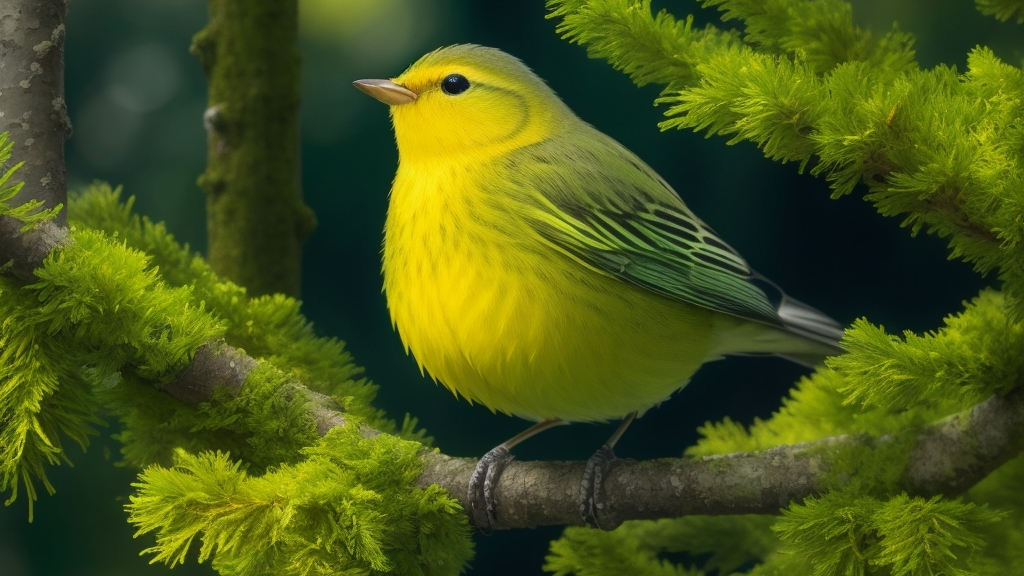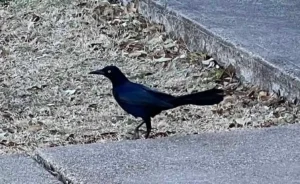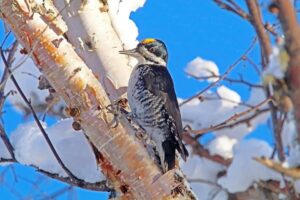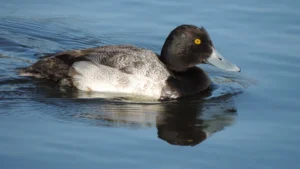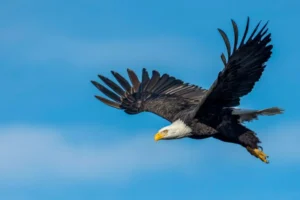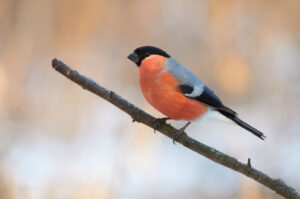Do you ever find yourself captivated by the melodious songs that echo through the evergreen forest? Well, prepare to be enchanted by the vibrant presence of the Pine Warbler.
This charming bird, with its striking yellow plumage, is known for creating a canopy of cheerful tunes that fills the forest. As you explore the depths of the evergreen wilderness, you will discover the unique nesting habits and impressive migratory journeys of these remarkable creatures.
Not only that, but you will also witness their intriguing behavioral patterns and interactions with other bird species. However, the Pine Warbler faces threats in its natural habitat, making conservation efforts crucial for its survival.
If you’re longing to witness the beauty and serenity of the evergreen forest, this article will provide you with tips on spotting and attracting these delightful birds right in your own backyard. Get ready to immerse yourself in the enchanting world of the Pine Warbler.
Key Takeaways
- Pine Warblers have vibrant yellow plumage and create a canopy of cheerful songs in evergreen forests.
- They prefer mature pine forests as habitat but can also inhabit mixed hardwood and pine forests, as well as pine plantations.
- Pine Warblers contribute to the evergreen forest ecosystem by controlling insect populations, aiding in reproduction, and dispersing pine seeds.
- Conservation efforts for Pine Warblers involve protecting and restoring their habitat, implementing sustainable forestry practices, and raising awareness about their importance.
Overview of the Pine Warbler’s Habitat and Distribution
The Pine Warbler’s habitat and distribution create a lush tapestry of evergreen forests, where their cheerful songs resonate throughout. These vibrant birds can be found across a large portion of eastern North America, from southern Canada to the Gulf Coast. They are especially abundant in the southeastern United States. Within this range, the Pine Warbler prefers to make its home in mature pine forests, where the tall, straight trunks of the trees provide the perfect perch for their melodious tunes.
One of the key features of the Pine Warbler’s habitat is the presence of a dense canopy of evergreen trees. These trees provide not only shelter and protection for the birds but also an abundant food source. The Pine Warbler feeds primarily on insects, which can be found among the pine needles and bark. Their beak is perfectly adapted for capturing these small creatures, allowing them to thrive in their evergreen domain.
In addition to their preference for evergreen forests, the Pine Warbler is also known to inhabit mixed hardwood and pine forests, as well as pine plantations. As long as there is a sufficient amount of tree cover and food supply, these birds are content to make their homes in a variety of forested habitats.
Overall, the Pine Warbler’s habitat and distribution contribute to the overall beauty and biodiversity of the evergreen forests they call home. Their cheerful songs and vibrant presence add a touch of joy to the tranquil serenity of these wooded landscapes.
Description of the Pine Warbler’s Striking Yellow Plumage
Imagine yourself in a vibrant, sunlit world where a small bird dazzles with its brilliant yellow feathers, creating a burst of color that seems almost unreal. This is the pine warbler, a beautiful songbird that stands out in the evergreen forest. Its striking yellow plumage is a sight to behold.
The pine warbler’s yellow coloration is most prominent on its underparts, throat, and face. Along its back, you will notice a mix of green and olive hues, blending perfectly with the surrounding foliage. This camouflage helps the bird blend seamlessly into its habitat, making it difficult for predators to spot.
To give you a closer look at the pine warbler’s plumage, here is a table showcasing its key features:
| Feature | Appearance |
|---|---|
| Underparts | Bright yellow |
| Throat and face | Vibrant yellow |
| Back | Green and olive blend |
As the pine warbler moves through the forest, its yellow feathers catch the sunlight, creating a mesmerizing display of color. It’s as if the bird is a walking ray of sunshine, bringing joy and brightness to its surroundings.
So next time you find yourself in the evergreen forest, keep an eye out for the pine warbler. Its striking yellow plumage is sure to captivate your attention and add a touch of magic to your outdoor experience.
Melodic Tunes: Exploring the Pine Warbler’s Song
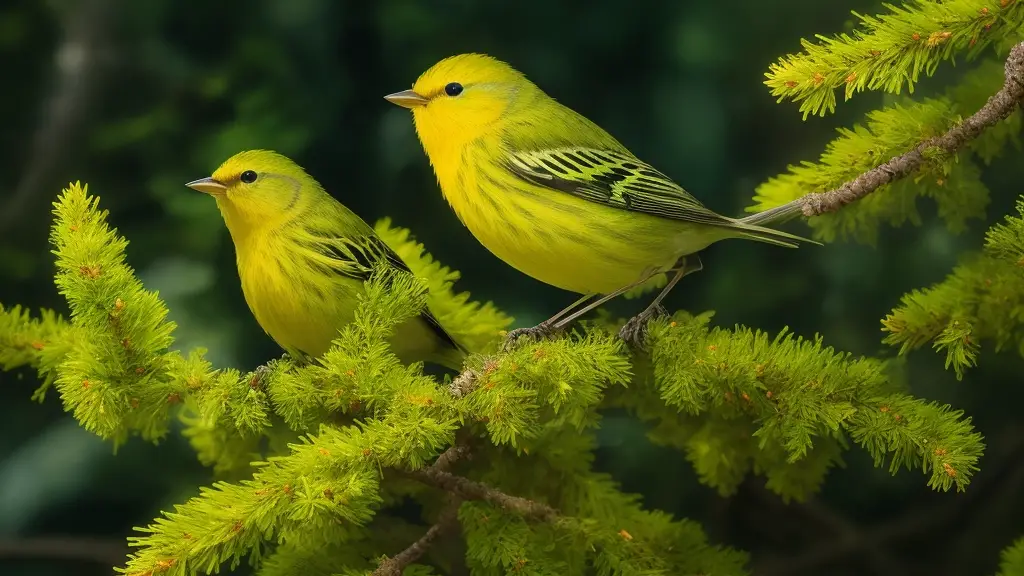
When you find yourself in the midst of an evergreen forest, prepare to be enchanted by the melodic tunes that emanate from a small bird with a voice as captivating as its vibrant yellow plumage. The pine warbler, with its cheerful songs, adds a layer of musicality to the canopy above. As you listen to its melodious tunes, you can almost feel the joy that radiates from its singing.
The pine warbler’s song is a complex and varied melody, filled with trills, warbles, and sweet notes that seem to dance through the air. Its voice is clear and pleasing to the ear, a true testament to the beauty of nature’s music. As you stand beneath the towering evergreen trees, you can’t help but be drawn into the enchantment of its song.
The pine warbler’s repertoire consists of a series of notes that it weaves together in a harmonious symphony. Its song is a reflection of its surroundings, mimicking the rustling of the leaves and the gentle swaying of the branches. It is a song that celebrates life in the evergreen forest, filling the air with a sense of tranquility and serenity.
So, the next time you find yourself in the midst of an evergreen forest, take a moment to listen to the melodic tunes of the pine warbler. Let its cheerful songs transport you to a world where nature’s music reigns supreme, and where the beauty of a small bird’s voice can bring joy to your heart.
Unique Nesting Habits of the Pine Warbler
Prepare to be amazed by the peculiar nesting habits of this small bird with a voice that could rival any opera singer. The Pine Warbler, known for its cheerful songs, also has unique nesting behaviors that set it apart from other birds. Instead of building its nest in the branches of trees like many birds do, the Pine Warbler prefers to nest on the ground. This unusual choice provides the bird with a level of protection from predators and allows it to blend in with its surroundings.
To create its nest, the Pine Warbler uses a variety of materials, including twigs, grass, moss, and even pine needles. The bird carefully weaves these materials together to form a sturdy and cozy structure. Interestingly, the Pine Warbler also lines its nest with soft materials such as feathers, fur, and plant fibers, providing additional insulation and comfort for its eggs and young.
To give you a better understanding of the Pine Warbler’s nesting habits, here is a table detailing some key information:
| Nesting Habit | Description |
|---|---|
| Nest Location | On the ground |
| Nest Materials | Twigs, grass, moss, pine needles |
| Nest Lining | Feathers, fur, plant fibers |
These unique nesting habits make the Pine Warbler a truly fascinating bird to observe. So next time you find yourself in the evergreen forest, keep an eye out for this little singer and its remarkable nest.
Impressive Migratory Journeys of the Pine Warbler
Get ready to be amazed by the incredible migratory journeys undertaken by this small bird with a voice that could rival the most talented opera singers! The Pine Warbler, despite its small size, embarks on epic journeys that span thousands of miles. Here are three fascinating facts about their impressive migratory habits:
- Long-Distance Travelers: Pine Warblers are known for their long-distance migrations. Every fall, they leave their breeding grounds in the northern parts of their range and fly south, crossing vast bodies of water and navigating through unfamiliar landscapes. Some individuals even travel as far as Central America and the Caribbean, making this tiny bird a true avian explorer.
- Timing is Everything: These remarkable birds have an impeccable sense of timing. They start their journey southward precisely when food becomes scarce in their breeding grounds. By timing their departure perfectly, they ensure access to abundant food sources in their wintering habitats, where they can feast on insects and berries.
- Remarkable Navigation Skills: Despite their small size, Pine Warblers possess exceptional navigation skills. They use a combination of visual landmarks, the position of the sun, and Earth’s magnetic field to find their way across vast distances. It’s truly astonishing how they can navigate accurately, even without the help of maps or GPS!
In conclusion, the migratory journeys of the Pine Warbler are nothing short of extraordinary. From their long-distance travels to their impeccable timing and remarkable navigation skills, these birds continue to inspire awe and admiration among bird enthusiasts worldwide.
The Pine Warbler’s Role in the Evergreen Forest Ecosystem
Nestled among the towering giants of the woodland, the Pine Warbler weaves its melodious tune, harmonizing with the rustling leaves and whispering winds, playing a vital role in the symphony of the thriving ecosystem. This small but mighty songbird is not just a delightful performer; it also serves as a key player in maintaining the balance of the evergreen forest.
| Column 1 | Column 2 | Column 3 |
|---|---|---|
| Pest Control | Pollination | Seed Dispersal |
| The Pine Warbler helps control insect populations by feasting on pests such as caterpillars and beetles. It acts as a natural pesticide, protecting the evergreen trees from potential damage. | As the Pine Warbler flits from one tree to another, it inadvertently transfers pollen from the male cones to the female cones, aiding in the reproduction of evergreen species. | After consuming pine seeds, the Pine Warbler disperses them through its droppings, facilitating the growth of new trees in different areas of the forest. |
The Pine Warbler’s foraging behavior contributes to the overall health and biodiversity of the evergreen forest. By consuming pests and acting as a pollinator and seed disperser, it helps maintain a delicate ecological balance. Without this feathered musician, the forest would face challenges in reproducing and controlling insect populations.
In conclusion, the Pine Warbler’s presence in the evergreen forest is not just about its cheerful songs. It is an essential player in the intricate web of life, ensuring the continued vitality and harmony of this remarkable ecosystem.
Importance of the Pine Warbler’s Cheerful Songs
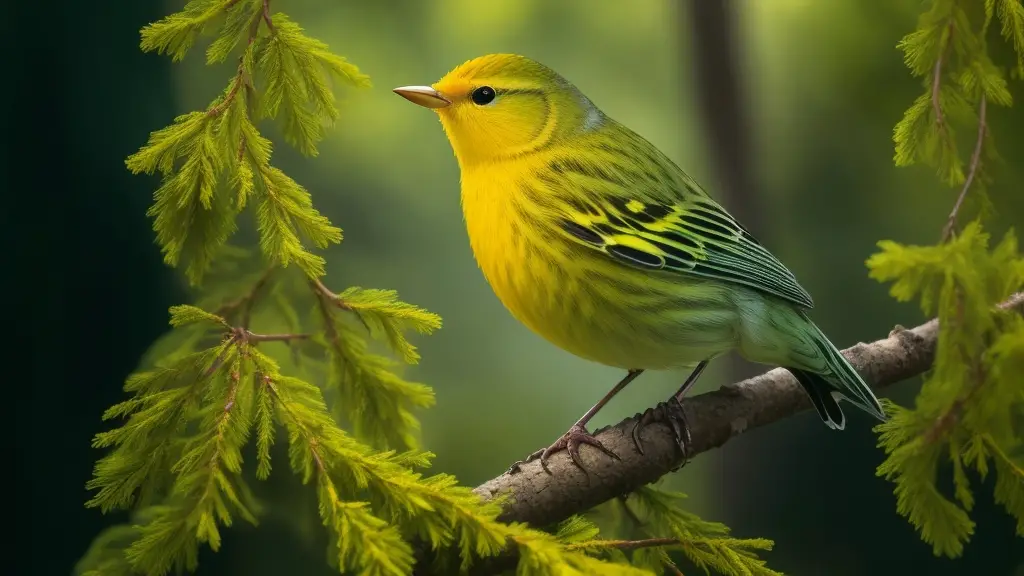
Immerse yourself in the symphony of nature as you listen to the enchanting melodies that emanate from the depths of the towering woodland. The cheerful songs of the Pine Warbler play a vital role in the evergreen forest ecosystem, bringing a sense of joy and harmony to the surrounding environment.
These delightful melodies serve multiple purposes. Firstly, they act as a form of communication among the Pine Warbler community. Through their songs, these small birds convey important messages about territorial boundaries, mating availability, and potential threats. Their tunes are a language that helps to maintain order and balance within their community.
Secondly, the cheerful songs of the Pine Warbler have a profound impact on the forest ecosystem as a whole. Their melodies attract insects, serving as a natural pest control mechanism. Insects are drawn to the sweet sounds and become easy prey for these skilled foragers. By keeping insect populations in check, Pine Warblers help to maintain the health and balance of the evergreen forest.
Lastly, the cheerful songs of the Pine Warbler bring a sense of tranquility and beauty to anyone fortunate enough to witness their performance. These melodies have the power to lift spirits and create a sense of connection with nature. They remind us of the intricate web of life that exists within the towering trees and inspire us to cherish and protect this precious ecosystem.
In conclusion, the importance of the Pine Warbler’s cheerful songs cannot be overstated. They serve as a form of communication, act as a natural pest control mechanism, and bring beauty and tranquility to the evergreen forest. So, the next time you find yourself in the woods, take a moment to appreciate the melodies of the Pine Warblers and let their songs fill your heart with joy.
Behavioral Patterns and Interactions with Other Bird Species
Behold the astonishingly dramatic behavioral patterns and interactions of the Pine Warbler with various bird species! This vibrant little bird is not only known for its cheerful songs but also for its fascinating social behavior.
The Pine Warbler is often observed forming mixed-species foraging flocks with other songbirds, such as chickadees, nuthatches, and titmice. Together, they scour the evergreen forest, searching for insects hidden deep within the foliage.
Within these flocks, the Pine Warbler displays an interesting hierarchy. They often take the lower positions in the pecking order, allowing other species to take the lead. This cooperative behavior ensures efficient foraging and maximizes the chances of finding food. It’s truly a sight to behold as these birds hop from branch to branch, communicating through soft chirps and calls.
Interestingly, the Pine Warbler also engages in ‘mobbing’ behavior. When they spot a potential predator, such as a hawk or an owl, they join forces with other birds in the area to harass and drive away the threat. This collective defense strategy not only protects the Pine Warbler but also benefits the entire avian community.
In conclusion, the Pine Warbler’s behavioral patterns and interactions with other bird species are nothing short of astonishing. Their cooperative foraging and mobbing behavior demonstrate their social nature and their willingness to work together for the common good. So next time you find yourself in the evergreen forest, keep an eye out for the Pine Warbler and witness their captivating interactions with their feathered friends.
Threats and Conservation Efforts for the Pine Warbler
Now that you’ve learned about the fascinating behavioral patterns and interactions of the Pine Warbler with other bird species, let’s shift our focus to the threats it faces and the conservation efforts in place to protect this vibrant songbird.
Sadly, the Pine Warbler is not immune to the perils of habitat loss and fragmentation. As forests are cleared for urbanization and agriculture, the evergreen sanctuaries that these birds call home diminish in size and quality. Additionally, climate change poses a significant threat, as it alters the delicate balance of temperature and precipitation that the Pine Warbler relies on for nesting and foraging.
Fortunately, there are dedicated conservation efforts aimed at safeguarding the Pine Warbler and its habitat. These initiatives include:
- Protecting and restoring crucial pine forests
- Implementing sustainable forestry practices
- Creating habitat corridors to connect fragmented areas
- Raising awareness about the importance of preserving the Pine Warbler’s habitat
- Monitoring and researching population trends to inform conservation strategies
By taking these proactive measures, we can ensure that the Pine Warbler continues to grace our evergreen forests with its cheerful songs and vibrant presence.
Let’s join forces to protect this remarkable species and preserve the beauty of our natural world.
Tips for Spotting and Attracting Pine Warblers in Your Backyard
To catch a glimpse of the vibrant songbird, try implementing these tips for spotting and attracting Pine Warblers in your own backyard.
- Create an inviting habitat by planting a variety of evergreen trees such as pine, spruce, and fir. These trees provide the perfect nesting and foraging grounds for the Pine Warblers.
- Consider installing feeders filled with suet, sunflower seeds, and mealworms. Pine Warblers are particularly fond of these food sources and will be drawn to your yard in no time.
When it comes to spotting these beautiful birds, keep an eye out for their distinct features.
- Pine Warblers have olive-green plumage with yellow underparts and a prominent white eye-ring.
- Their songs are also a giveaway, as they have a cheerful and melodic tune that echoes through the evergreen forest.
To increase your chances of attracting Pine Warblers, provide them with fresh water sources.
- This can be achieved by placing a birdbath or small pond in your backyard.
- Make sure to keep the water clean and regularly refill it to keep the birds hydrated.
Lastly, avoid using pesticides and herbicides in your yard.
- These chemicals can be harmful to the Pine Warblers and other bird species.
- Instead, opt for natural pest control methods to create a safe environment for these delightful songbirds.
By following these tips, you’ll create a welcoming haven for Pine Warblers in your backyard, allowing you to enjoy their cheerful songs and vibrant presence all year round.
Enjoying the Beauty and Serenity of the Evergreen Forest with the Pine Warbler
Immerse yourself in the tranquil splendor of the lush, green landscape, where the melodious tunes of the Pine Warbler harmonize with the gentle rustling of the towering pines. As you venture into the evergreen forest, you will be captivated by the beauty and serenity that surrounds you. Here are five ways to fully enjoy this enchanting experience:
- Take a leisurely stroll along the winding forest trails, allowing the soothing melody of the Pine Warbler to guide your steps.
- Find a comfortable spot to sit and observe the intricate dance of sunlight filtering through the dense canopy of needles. Close your eyes and let the peaceful ambiance envelop you.
- Bring a picnic blanket and your favorite book, and settle down beneath the shade of a majestic pine tree. Allow the tranquility of the forest to transport you to a place of relaxation and rejuvenation.
- Practice mindfulness by focusing on the gentle rustling of the leaves, the crisp scent of pine in the air, and the vibrant colors of the surrounding flora and fauna. Let the forest be your sanctuary.
- Capture the moment with your camera, attempting to capture the essence of the Pine Warbler’s joyous melodies and the ethereal beauty of the evergreen forest.
In this haven of natural wonders, the Pine Warbler’s cheerful songs provide the soundtrack to your peaceful escape. Allow yourself to be swept away by the enchanting symphony and bask in the tranquility of this extraordinary setting.
Pine Warbler: FAQs
What is the average lifespan of a Pine Warbler?
The average lifespan of a pine warbler is around 5 years. These cheerful birds bring a lively atmosphere to the evergreen forest with their beautiful songs and vibrant presence.
How many eggs does a Pine Warbler typically lay in one nesting season?
Pine warblers typically lay 3-5 eggs in one nesting season. They choose a cozy spot in the forest and diligently incubate the eggs until they hatch. The parents then raise and care for their young until they are ready to leave the nest.
Can Pine Warblers mimic the songs of other bird species?
Yes, pine warblers have an amazing talent for mimicking the songs of other bird species. You won’t believe how they flawlessly imitate the melodious tunes, adding a touch of mystery to the forest.
How do Pine Warblers communicate with each other?
Pine warblers communicate with each other through a variety of cheerful songs. They use their unique melodies to establish territories, attract mates, and communicate with other members of their flock.
What are the main threats to the Pine Warbler’s population and what conservation efforts are being made to protect them?
The main threats to the pine warbler’s population are habitat loss and climate change. Conservation efforts include protecting their habitats, promoting sustainable forestry practices, and raising awareness about the importance of preserving this species.
Conclusion
Next time you find yourself in the evergreen forest, keep an ear out for the cheerful tunes of the pine warbler. Let their melodic songs transport you to a world of serenity. Their striking yellow plumage and unique nesting habits make them a true marvel of nature.
With their impressive migratory journeys and interactions with other bird species, the pine warbler truly stands out. So, why not create a welcoming space in your backyard and invite these delightful creatures to brighten up your days with their cheerful melodies?
Can you imagine the joy of having your own personal concert right outside your window?

